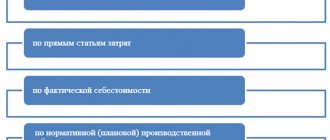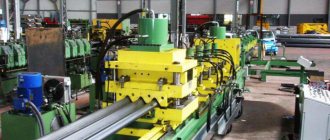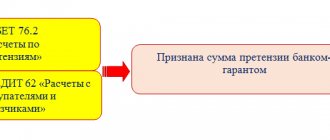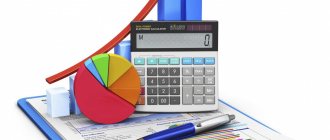The release of finished products is often accompanied by the formation of residues of raw materials, which to one degree or another have lost their original properties. They are called waste, and if it is possible to reuse it in the main or auxiliary production, as well as resell it to consumers, then such waste is returnable. For example, dairy production is always accompanied by the formation of whey products, and forest processing - sawdust and chips; returnable waste in the confectionery industry is benign residues after cutting candy layers, deformed candy bodies (depending on the composition, they are reused in the preparation of special types of candies, syrups).
And although the concept of “returnable waste” is absent in accounting legislation, it is specified in some industry instructions. In particular, paragraph. Methodological recommendations for accounting for production costs, approved. by order of the Ministry of Agriculture dated 06.06.2003 No. 792, this term denotes the remains of raw materials, goods and materials, coolants and other resources formed during the production of products, which have to some extent lost the properties of the original material and are therefore used with an increase in costs (reduction in product yield). Let us recall the features of accounting for such assets.
What is waste?
Waste at a production enterprise can be things that have completely or partially lost their consumer properties.
These include:
- Residual raw materials;
- Own products;
- Semi-finished products;
- Materials;
- Inventory balances;
- Heat carriers.
They are divided into two groups:
- returnable waste;
- irrevocable.
Important! Returnable waste must be distinguished from all types of materials, distinguished from related products and other assets, since the correct calculation of cost, and, consequently, the tax base, depends on such differentiation.
Documentation of waste and posting
Technological losses, the scope of which was previously approved by the chief technologist or engineer, must be constantly under the control of an economist or technologist. The amount of waste must be reflected in the inventory or cleanup report.
Accounting entries for writing off returnable waste if it arose as a result of processing, production, transportation or exceeded its norm. If the losses have not exceeded their limit, then attribute these expenses to the costs of ordinary activities (they affect the write-off of raw materials for the main production).
Typical wiring:
| Account Dt | Kt account | Wiring Description | Transaction amount | A document base |
| 20, 23 | 10.01 | Transfer of materials to production | Material cost | Consignment note, receipt order |
| 91.02 | 20.01, 23 | Write-off of excess losses | The size of the difference with the limit | Write-off act |
| 94 | 41.01 | Reflection of shortages in goods. This happens when processing contaminated products, cleaning cuts, and windward areas of the product. | Shortage amount | Cleanup act |
| 41.01 | 94 | Receipt of waste for further sale | Amount of waste | Receipt invoice, acceptance certificate |
| 44 | 94 | Write off expenses that do not exceed the limit | Amount of expenses | Write-off act |
| 76, 73 | 94 | Write-off of losses in excess of the norm with attribution to the perpetrators (they may be employees or representatives of other organizations) | Amount of difference with limit | Write-off act |
| 91.02 | 94 | Write-off of losses in excess of the norm in cases where the perpetrators were not found | The size of the difference from the norm | Write-off act |
| 94 | 60, 10, 16,41 | Reflection of shortages during transportation | Shortfall amount | Inventory report |
| 20.01, 23 | 94 | Writing off the shortfall as expenses within the established norm | Cost amount | Write-off act |
| 76, 73 | 94 | Transferring costs to the guilty parties in case of excess costs | Amount of losses | Accounting statement, inventory report |
| 91.01 | 94 | Write-off of losses in excess of the norm when the perpetrators are not identified | Amount of difference with limit | Accounting certificate-calculation, write-off act |
How are the types of waste different?
The separation of irretrievable and returnable waste is carried out according to their characteristics:
| Returnable waste | Irrevocable waste |
| Similarities | |
| Availability of material embodiment* Are a product of manufacturing processes Changed/lost properties in full or part of them | |
| Difference | |
| Bring income For future use: – in all types of production processes with increasing costs - for a purpose that does not correspond to the original one | Does not provide economic benefit Not used in this production, but: – suitable for the manufacture of other types of goods and products – possible release as related (by-product) products |
There is a type of waste classified as irrevocable, which does not have a material form, for example, such as: evaporation, volatilization, attrition, drying of materials.
Features of recycling irrevocable waste
If production residues cannot be reused, then they are recognized as irrecoverable solid waste. In this case, their cost is included in the cost of products, the production of which led to their appearance.
Waste of this type is subject to disposal based on the internal act of the organization. According to the rules, the disposal of industrial waste is carried out by specialized companies that have a license for this type of activity. Payment for their services is included in accounting documents as other expenses.
Irrevocable waste is a kind of loss for any enterprise. You cannot profit from them, but you must spend money on legal disposal. In this regard, most enterprises strive to increase the number of returnable waste in industrial processes and reduce the amount of non-returnable waste.
This economic production model has a beneficial effect on the environment and the overall amount of solid waste. Thus, recycling waste ceases to be an obsession of environmentalists, but appears as a profitable business model. Accordingly, the goal of each enterprise is to maximize the level of returnable waste and make a profit from it.
What documents are used to document waste in a warehouse?
Those wastes that are identified during the manufacture of products must be:
- counted and weighed;
- delivered to the warehouse.
Important! If it is not possible to count and weigh the resulting waste, a calculation method is used: the quantity of products is multiplied by the standard of expenditure approved by documents.
For delivery and registration of arrival at the warehouse and sale, the following documents are used:
| Form name | Document |
| MX-18 | Invoice for transfer of products to the warehouse |
| M-4 | Warehouse receipt order |
| M-11 | Requirement-invoice, which records the release upon re-entry into production |
| TORG-13 | Invoice for the transfer of goods, containers when moving within the company |
| TORG-17 | A journal that records the safety and movement of products within warehouses |
| M-8 | Limit-fence card for releasing when re-using in the manufacture of products |
| M-15 | Invoice for shipment to the third party when releasing to another organization |
| TORG-12 | Sales invoice |
Important! These documents are the basis on which costs and expenses are reduced in accounting and tax accounting, respectively. The storekeeper does not indicate the value of the capitalized assets; this is subsequently done by the accounting department by filling out the appropriate columns based on the calculation of the cost of expenses incurred.
All accounting documents must contain information about expenses.
Such data includes:
- Amount of waste;
- Units in which they are measured (pieces, kg, m, sq.m);
- Price.
Important! Since 2013, organizations can use documents developed by them independently, but subject to their mandatory approval by the manager and indication of the necessary details - those that comply with the requirements of accounting legislation.
Accounting
Due to the variety of types of waste and methods of their disposal, various posting and accounting schemes can be used. Let us dwell on the most significant aspects of waste management by the original owner and by a company working in the field of recycling.
From the owner
Control over the movement of returnable waste and its disposal begins with the owner building detailed analytical records: by type of product, location of waste generation, information on its qualitative and quantitative composition. To calculate the generated waste, actual measurements, weighings are used, or a calculation method is used according to standards per unit of production.
When recycling by selling returnable waste externally, the following transactions can be generated:
- Dt 10/6 Kt 20, 23 – waste was capitalized from production;
- Dt 62 Kt 91/1 – revenue from the sale of returnable waste is recorded;
- Dt 91/VAT Kt 68/VAT – tax is charged on revenue;
- Dt 91/2 Kt 10/6 – written off from the cost of returnable waste;
- Dt 51 Kt 62 – payment received;
- Dt 90/9 Kt 99 – profit was received from the sale of returnable waste.
The owner can dispose of waste by transferring it to production within his organization. For this purpose, the reverse wiring to that given above is used: Dt 20.23 Kt 10/6 - transfer of waste to production.
In a specialized company
Disposal costs here relate to ordinary activities in accordance with PBU 10/99. Expenses are recognized in the accounting system in accordance with clause 18 of the specified document, depending on whether the cash method of income recognition is used or not.
If returnable waste is purchased for use in your own production, count 10 applies.
Postings:
- Dt 10 Kt 60, 76 – secondary raw materials from the supplier were capitalized;
- Dt 60, 76 Kt 50, 51 – payment to the supplier for secondary raw materials.
If the acquisition was made for further resale, the raw materials act as goods (41).
Let the organization use a common BUT system. The implementation transactions will be as follows:
- Dt 62 Kt 90/1 – sales revenue;
- Dt 90/VAT Kt 68/VAT – VAT is charged on sales;
- Dt 90/2 Kt 41 – written off from the cost of waste sold;
- Dt 51 Kt 62 – money received for sold raw materials;
- Dt 90/9 Kt 99 – profit from the resale of raw materials.
There are often cases when a company enters into an agreement with an organization or a network of retail outlets for the free transfer of waste and garbage, for example, used paper and wooden containers for the purpose of recycling on its own. The terms of the agreement may provide for payment by counterparties. In such cases, the key account will be 98/2 - “deferred income, gratuitous receipts.”
Postings:
- Dt 10, 15 Kt 98/2 – free receipt of goods and materials, in market (contractual) valuation;
- Dt 20, 23 Kt 10 – raw materials sent for processing;
- Dt 98/2 Kt 91/1 – non-operating income from gratuitous receipt of goods and materials;
- Dt 76 Kt 90/1, 91/1 – processing services, revenue from sales (work) is reflected;
- Dt 90/VAT, 91/VAT Kt 68/VAT – charge of VAT on processing services;
- Dt 50, 51 Kt 76 – payment for processing services;
- Dt 40, 43 Kt 20, 23 – production of finished products, the result of waste disposal.
Disposal can be documented with the following primary documents:
- act of acceptance and transfer;
- invoice for the release of materials to the third party;
- packing list;
- processing report;
- certificate of completion;
- demand-invoice;
- limit fence card.
When recycling waste with the help of a specialized company, an agreement is concluded (on disposal, on waste processing).
By the way! When processing customer-supplied raw materials, the customer is the owner of the generated waste. Returnable waste either reduces the cost of the original raw materials transferred for processing, or reduces the cost of the processor's services.
Reflection in tax accounting
When recording the movement of returnable waste in tax accounting, you must be guided by the following instructions of the Tax Code of the Russian Federation:
- When using the accrual method, the cost of waste, defined as returnable, reduces the organization’s costs in the tax period corresponding to the tax period of their secondary receipt into production.;
- It should be taken into account that the day on which they were actually used (re-entered into production or on sale) is not taken into account;
- It is also necessary to remember that when calculating income tax, when total expenses are reduced by returnable waste, it is necessary to document them accordingly using the above registers.
Important! Returnable waste in both types of accounting has the same reflection: their receipt is recorded on the day they appeared, and the decrease in the cost of products occurs in the same tax period.
Tax accounting of returnable waste
In the Tax Code, the definition of VO is given in paragraph 6 of Art. 254. The legislator clarifies that if the remaining materials are used for the manufacture of other goods by other divisions as full-fledged material, then they are not VO, just like by-products.
It is necessary to reduce the amount of material costs by the cost of returnable materials, and the method for assessing VO directly depends on their future fate:
- use - the price of possible use or the reduced price of raw materials;
- sale - selling price.
In the first case, the assessment method is determined using special calculations, which depend on the type of production, the material used, and the technological process. The calculation takes into account the beneficial properties of the waste, the beneficial properties of the product that will be obtained from this waste, physical indicators, etc. For each enterprise this will be its own specific calculation, which needs to be fixed in the accounting policy.
As for sales, if the sales price is already fixed in the contract or specification, then there are no problems. If it is not yet known what price of the transaction will be set, then the question of its determination will affect the amount of material costs. The desire to reflect the VO at the actual actual selling price that will be established in the future can become a serious problem for the accountant. Why? Let's consider two options:
- the receipt of waste and its sale occurred in the same reporting period;
- The receipt of waste occurred in the current period, and their sale - in the next.
If we did not guess correctly with the selling price and capitalized the waste at an underestimated or overestimated cost, then in the first case we will find that the reduction in material costs and the increase in the cost of goods sold will occur by the same amount. Therefore, the income tax result will not be affected.
If we underestimate the selling price of waste in the second case, then the material costs of the current period will be overestimated, which leads to underpayment of income tax, penalties and fines. And in the next period, on the contrary, it will overpay. You will have to submit clarifications and answer questions from tax specialists, which is extremely undesirable. Therefore, let us turn to the explanations of the Ministry of Finance. Letters dated 04/26/2010 No. 03-03-06/4/49, dated 09/18/2009 No. 03-03-06/1/595 state: “VO should be assessed based on market prices determined in the manner prescribed by Art. 40 of the Code." Let us clarify that the market price is determined at the time of receipt of waste, because that is when we need to evaluate it for reflection in accounting.
The Ministry of Finance also explains in the mentioned letter No. 03-03-06/4/49 that when selling VO, revenue is reduced by their value determined in tax accounting, and profit from such a transaction is taxed. It is worth noting that no one is insured against loss, since the amount of income from the sale determined in accordance with clause 1 of Art. 249 of the Tax Code of the Russian Federation, may be less than the cost of waste, which is included in expenses in accordance with subparagraph. 2 p. 1 art. 268 of the Tax Code of the Russian Federation and for which material costs were reduced. Let's look at the example of accounting and tax accounting of VO.
Example
LesTorg LLC sells VO - sawdust that remains after processing logs into timber. Let's assume that the cost of manufacturing the timber amounted to 8,756,000 rubles. before accounting for VO. 1 ton of sawdust has been received into the warehouse, the selling price of which is 5 rubles. per kg excluding VAT. LesTorg has an agreement concluded with the buyer, which stipulates the specified price. The manufactured timber was sold for RUB 11,388,000, including VAT of RUB 1,898,000.
| Operation | Dt | CT | Amount, thousand rubles |
| The costs of manufacturing timber are reflected | 20 | 02, 10, 70, 69, | 8 756 |
| Posted to the VO warehouse | 10.6 | 20 | 5 |
| The cost of finished products is reflected | 43 | 20 | 8 751 |
| Reflected revenue from the sale of timber | 62 | 90.1 | 11 388 |
| VAT on the sale of timber is reflected | 90.3 | 68 | 1 898 |
| The cost of timber is reflected | 90.2 | 43 | 8 751 |
| Finnish reflected result from the sale of timber | 90.9 | 99 | 900 |
| Reflected revenue from the sale of sawdust | 62 | 91.1 | 739 |
| VAT on the sale of sawdust is reflected | 91.2 | 68 | 1 |
| The cost of sawdust is reflected | 91.2 | 10.6 | 6 |
| Finnish reflected result from the sale of sawdust | 91.9 | 99 | 0 |
In tax accounting we receive the following data:
| Index | Finished products - timber, thousand rubles. | Returnable waste - sawdust, thousand rubles. | Total, thousand rubles |
| Sales income | 9 490 | 5 | 9 495 |
| Cost price | 8 751 | 5 | 8 756 |
| Taxable income | 739 | 0 | 739 |
Let's consider the situation if LesTorg LLC did not have an exact amount for the sale of returnable waste, but used market prices. For example, the market price of sawdust at the time of their receipt was 3 rubles. per kg (the selected price can be fixed by attaching, for example, a competitor’s price list to the primary documents). LesTorg LLC sold 1 ton of returnable waste for the same price of 5 rubles. per kg excluding VAT (VAT - 0.833 rubles). We receive the following entries in accounting.
| Operation | Dt | CT | Amount, thousand rubles |
| The costs of manufacturing timber are reflected | 20 | 02, 10, 70, 69, | 8 756 |
| Posted to the VO warehouse | 10.6 | 20 | 3 |
| The cost of finished products is reflected | 43 | 20 | 8 753 |
| Reflected revenue from the sale of timber | 62 | 90.1 | 11 388 |
| VAT on the sale of timber is reflected | 90.3 | 68 | 1 898 |
| The cost of timber is reflected | 90.2 | 43 | 8 753 |
| Finnish reflected result from the sale of timber | 90.9 | 99 | 737 |
| Reflected revenue from the sale of sawdust | 62 | 91.1 | 6 |
| VAT on the sale of sawdust is reflected | 91.2 | 68 | 1 |
| The cost of sawdust is reflected | 91.2 | 10.6 | 3 |
| Finnish reflected result from the sale of sawdust | 91.9 | 99 | 2 |
In tax accounting we receive the following data:
| Index | Finished products - timber, thousand rubles. | Returnable waste - sawdust, thousand rubles. | Total, thousand rubles |
| Sales income | 9 490 | 5 | 9 495 |
| Cost price | 8 753 | 3 | 8 756 |
| Taxable income | 737 | 2 | 739 |
How waste is valued in accounting
Important! Accounting legislation gives the company the right to use any of the methods by which waste is assessed, regardless of its future purpose (sale or release into production). In this case, it is necessary to prescribe the methodology by which the price is determined in the accounting policy.
Inventory accounting, as defined by the guidelines for inventories, is carried out according to:
- The price at which they can be used;
- Selling price.
Important! If accounting uses the price of waste that corresponds to the possible or estimated selling price, then a situation may arise when the price changes upon sale. In this case, no adjustment is made for the resulting difference. In this case, the company either has other income or a loss.
Recycled raw materials
Sources of secondary raw materials can be:
- returnable waste from materials used in the production process (for example, in the woodworking industry - shavings, in the clothing industry - fabric scraps, in metallurgy - scrap metal, etc.);
- irretrievable waste (technological losses), the further use of which in the production of products is impossible (defective products, materials obtained during the dismantling of fixed assets, finished products not sold during the warranty period).
The remnants of industrial products, which, in accordance with the technological process, are transferred to other departments as full-fledged raw materials (materials) for the production of other types of goods (works, services), as well as associated (associated) products obtained as a result of the technological process, are not returnable waste.
The cost of recorded waste is included in the reduction of the cost of materials released into production.
In the case of subsequent use of waste for the manufacture of products (parts, etc.), their release into production is documented by issuing invoice requirements.
Returnable waste is accepted for accounting as the debit of account 10 “Materials”, subaccount 6 “Other materials”, and the credit of accounts 20 “Main production”, 23 “Auxiliary production”, etc.
Subaccount 10-6 “Other materials” takes into account the presence and movement of: production waste (stumps, trimmings, shavings, etc.); irreparable marriage; material assets received from the disposal of fixed assets that cannot be used as materials, fuel or spare parts in a given organization (scrap metal, waste materials); worn tires and scrap rubber, etc. Production waste and secondary material assets used as solid fuel are accounted for in subaccount 10-3 “Fuel” (example 2).
Example 2. Let's assume that returnable waste received in July 2012 is intended for sale. Based on the market price for such raw materials, waste is estimated at 28,000 rubles. and sold in October 2012 for 30,000 rubles. (excluding VAT).
Sales of returnable waste are reflected in table. 2.
table 2
| Correspondence of accounts (sub-accounts) | Amount, rub. | ||
| D-t | Kit | ||
| As of the date of identification of returnable waste (July 2012) | |||
| The amount of expenses for main production was reduced by the market value of returnable waste | 10, subaccount. "Returnable waste" | 20 | 28 000 |
| As of the date of sale of returnable waste (in October 2012) | |||
| Revenue from the sale of returnable waste is reflected | 62 | 91-1 | 35,400 ((30,000 + 30,000) x 18%) |
| The cost of waste sold is reflected | 91-2 | 10, subaccount. "Returnable waste" | 28 000 |
| VAT charged on sales | 91-2 | 68-VAT | 5,400 (30,000 x 18%) |
Tax accounting for the sale of returnable waste is presented in table. 3.
Table 3
| Operation | Type of income | Amount, rub. |
| Based on the results of the month in which returnable waste was identified (July 2012) | ||
| Reduced the amount of material costs for the cost of returnable waste | Adjustment of material costs | 28 000 |
| Based on the results of the month of sales of returnable waste (October 2012) | ||
| Income from the sale of returnable waste is taken into account | Sales income | 30 000 |
| Expenses from the sale of returnable waste are taken into account | Sales expense | 28 000 |
Valuation in tax accounting
The Tax Office points out that there are two ways to assess waste:
- At the possible price of use in production, which is lower than that of the source material;
- At the market price when the waste is intended for sale.
Important! Tax accounting differs from accounting in that the former depends on the valuation of waste on how it will be used in the future. As in accounting, in tax accounting, if the actual sale price is not identical to the capitalization price, it is not revalued.
Disposal procedure
The owner can go two ways.
- Entrust removal and further disposal to a specialized company. To do this, you will need accounting data on waste volumes recorded in documents. Hazardous waste (Article 4.1 of Federal Law-89) requires a disposal license.
- Independently take into account waste and make decisions about its disposal, for example, about transferring waste to production.
IMPORTANT! A sample agreement on industrial waste disposal from ConsultantPlus is available here
In order to have grounds for reflecting recycling in accounting and accounting records, it is necessary to create an internal waste write-off commission. It includes technical specialists, economic service employees, and the manager. The commission determines the inventory items to be disposed of. The decision of the commission is formalized in an act.
Accounting for a single tax on imputed income
Unlike accounting for returnable waste under the main taxation system, an organization that pays a single tax on imputed income, according to the Tax Code of the Russian Federation, cannot sell goods that it itself produces. Returnable waste also falls under this rule. Such an enterprise can sell only purchased goods at retail using the UTII system. If an enterprise produces products on UTII, then in this case it needs to organize separate accounting:
- When combining “imputation” and the main system - separate accounting for UTII, profit and VAT;
- When combining “imputed” and “simplified” - accounting for UTII and tax according to the simplified tax system.
Accounting entries for production waste
Even with modern and efficient equipment, there will always be a working process in which waste from the main stage of raw material processing will remain. Let's consider the main accounting entries for industrial waste and their classification.
Also, waste from the main production may appear due to:
- transportation,
- due to improper storage,
- due to the chemical and physical properties of the products.
Specialists of any production are required to set a specific waste limit. If it is not possible to determine the exact level of such output, then industry regulations and standards are taken as the basis. Production losses must always be formally documented in accounting records, even in transit.
Technological loss standards
An organization can develop process loss standards for each specific type of raw material independently. This can be done by the organization’s specialists who control the technological process (for example, technologists). The developed standards must be supported by technological maps, process estimates or other similar documents. They must be approved by persons authorized by the organization's management (for example, chief technologist or chief engineer). If an organization cannot determine the loss limit on its own, then it has the right to use industry regulations, government standards or information from competent organizations. For example, in the electric power industry, the calculation and redistribution of technological losses between participants in the wholesale market is carried out by the operator JSC ATS. The very size of the technological loss standards is determined by the Russian Ministry of Energy.
The organization must confirm the actual losses of raw materials and materials with primary documents (for example, during transportation, this could be a report from the transport company, a contract, a waybill). This point of view is confirmed by letters of the Ministry of Finance of Russia dated July 5, 2013 No. 03-03-05/26008, dated January 31, 2011 No. 03-03-06/1/39, dated October 1, 2009 No. 03-03- 06/1/634, dated September 21, 2007 No. 03-03-06/1/687, dated August 29, 2007 No. 03-03-06/1/606, dated August 14, 2007 No. 03-03 -05/218, dated March 27, 2006 No. 03-03-04/1/289.
Advice: if an organization develops standards independently, take into account the quality of incoming materials (for example, the degree of contamination) or the degree of wear and tear of equipment (for example, standards for the same type of materials processed on different equipment may differ). Correctly calculated standards will minimize excess losses, which must be further justified.







